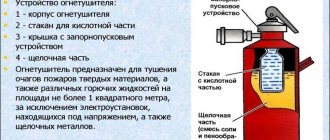Collimator sight
Sighting systems using a collimator are optical devices that provide alignment of aiming marks with the target image.
Cabin of Messerschmitt Me-262. The collimator sight is at the top, slightly to the right of the middle (looks like a metal box).
The collimator sight provides a very high aiming speed - about 2-3 times higher than traditional “fly sights” since when aiming you need to combine only two points - a red luminous mark, which is visible through the eyepiece and, in fact, the target itself.
Collimator sights come in open and closed types.
Closed ones are similar to an optical sight, only outwardly “thicker” and “shorter”. Their magnification ratio is only 1-1.5; for regular ones (so as not to reduce the viewing angle), to increase the magnification ratio to 1.5-2 or more, special attachments are used, although they can be equipped with optical attachments with additional magnification, that is, combining a collimator with an optical one sight.
Open ones have a simpler design and do not have a magnification factor at all. Just a glass screen through which the shooter looks at the target and sees a red aiming dot against the background of the target. In collimator sights, in addition to the aiming “dot” itself, additional auxiliary information can be projected.
The collimator sight was invented in Russia in 1917[1]. Since the First World War to the present day, red dot sights have been the main aerial gun sights for fighters, attack aircraft and bombers with fixed weapons and in semi-automatic sight systems for mobile gun mounts on attack aircraft and bombers.
Open collimator sight
An optical sight is simply hardball optics.
Special optical device for aiming. Among the differences are the presence of lenses, the presence of a reticle for aiming and possible calculations on the ground, and the ability to be used as binoculars. Shooting through optics requires a number of preparatory measures - a distance of several centimeters from the eye to the sight is necessary for better focusing, it is better to close the other eye, which, along with the size of the sight, reduces the field of visibility. What we are talking about is that the snipers of the squad should be assigned, and only really good rifles, and also an attack aircraft should be allocated for defense.
Optical sight
5. Collimator sight
Another type of sight for very fast aiming. Its essence is that there is a point that, from any viewing angle, always illuminates the aiming point. All that remains for the fighter is to place the barrel so that this point hits the target. All this is based on the collimator device. Those interested in optics can read relevant articles on the Internet. Due to the fact that the eye can be positioned as desired, the speed of aiming increases significantly. Here you should also note the correct spelling of the word itself - collimator (or whatever it is called). By the way, in hardball, the combination of Drozd and a collimator is quite common.
Collimator sight
Links
AK 47 vs M16
| AK-47 open sight with sector sight | Valmet Rk 62 with diopter sight | MP5 Diopter sight | diopter sight. flip rear sight, L-shaped |
| The combination rear sight is fixed with a V-shaped slot and an adjustable diopter that flips up. | M14 adjustable diopter rear sight on the rear of the receiver and front sight in the front sight on the muzzle of the barrel. |
Open sight
Open sight
- Holographic sight - a hybrid of time-tested optics and the latest technology
When using an open sight, the shooter must simultaneously keep three objects in focus: the target, the front sight and the rear sight. Since this is impossible, he looks at the rear sight, then he looks at the front sight, then at the target and, before firing, he looks at the front sight again. This needs to be done very quickly.
Diopter sight
Diopter sight View of a diopter sight
The shooter can ignore the rear sight, while looking through the aperture only at the front sight and target.
These days, such sights are used on most rifles, assault rifles, submachine guns and light machine guns.
Weapon sight: third eye
The Second World War was the heyday of sniper art.
Rifles with optical sights were widely used on both sides of the front. Marksmen and huntsmen fired their muskets using mainly diopter sights, which were then called ring sights. The ring sight consists of a ring that is attached to the weapon stock near the eye, and a front sight mounted at the point where the projectile is launched.
This simple device greatly simplifies aiming and increases shot accuracy. When aiming, the shooter looks through the ring, while the front sight is in the center. The ring itself does not cover the target and makes it possible to easily select the required lead when shooting at moving objects.
Compared to an open sight, where the eye must check several points simultaneously: the top edges of the slot, the front sight and the target, in a ring sight the shooter focuses only on the target and the front sight, without being distracted by the vague outlines around the sight opening. Diopter sights made it possible to shoot at fantastic distances for those times - up to 300 meters.
And the ease of manufacture and installation made it possible to widely use them in hunting and war. For almost a hundred years, there was no need for other sighting devices, since the weapon itself did not allow shooting at long distances.
The creation of rifled weapons dates back to the 16th century, but the first rifles with a rifled barrel, capable of accurately shooting at a distance of more than 300 m, appeared only in the 18th century in Pennsylvania. This was the impetus for the development of devices for precision shooting.
| A simple diopter looks like a round plate on a thin stem with a hole. |
It is interesting that European snipers hit only individual targets in the enemy ranks. A simple soldier had no right at all and did not dare to shoot at an enemy officer on his own initiative, without the order of the commander, otherwise his action was recognized as murder, unacceptable in a “honest” war. But on the American continent such “sentiments” were considered unnecessary.
A breakthrough in long-range shooting was the invention of the optical sight. At the beginning of the 18th century, Russian engineer Andrei Konstantinovich Nartov proposed an optical sight for guns. Nartov not only invented the sight, but also justified its use on firearms.
| More complex options allow you to make both horizontal and vertical adjustments. |
The first real use of a telescope in small arms was made by the Americans in the early 1800s. They installed long, heavy copper telescopes on the famous muzzle-loading Kentucky black powder rifles of the 1812 model.
The shooting results (5 bullets from a distance of 200 yards, i.e. 182 m) fit into a quadrangle with a side of 29 mm. Quite impressive even for a modern weapon! The aiming mark was in the form of a small dot, there was no reverse system, and the image in such a sight was upside down.
Alignment was carried out with external screws. After zeroing, the sight was fixed and corrections were introduced only by moving the aiming point upward. In a word, the equipping of small arms with optical sights began, and from that moment on it is difficult to imagine a sniper without a rifle with optics.
| The diopter can be used independently or as an addition to a traditional front and rear sight. |
In 1850, the Italian Porro used “reversing” prisms on telescopes. The prismatic bent tube was then improved by Abbe and Zeiss in Germany. Since the 1860s, rifle telescopes have been widely used on hunting rifles, only to some extent in target sport shooting, and very rarely on military rifles.
As usual, hunters were the first to appreciate all the advantages of a rifle equipped with optics. But, it must be admitted, the military did not pay attention to them not because they were short-sighted. It’s just that the first optical systems were extremely unreliable, sensitive to care and maintenance, and most importantly, they required qualified personnel.
Back then they didn’t even know what a sniper was and what his place on the battlefield was in tactical and strategic terms. The first snipers were recruited from hunters and sports shooters, often with their own personal weapons.
The first use of rifles with telescopic sights was during the American Civil War (1861–1865). Fixed telescopes up to 80 cm in length and longer were gradually improved, and in 1904 KAHLES patented the world's first system for introducing height correction into an optical sight.
| Regardless of the type of weapon, the use of diopters made it possible to increase the accuracy and effective shooting distance. |
The method of changing the magnification and aperture ratio was invented by Laporte, and the first sight with variable magnification “saw the light” in 1949. It was also introduced and patented by KAHLES, but later this method was significantly improved by Zeiss.
In general, it should be clarified that the KAHLES company undoubtedly made a breakthrough in the design and promotion of optics for rifles, but the sight itself was still invented much earlier.
| ABSOLUTELY SEALED. One of the problems that designers of optical sights were forced to solve was tightness. The fact is that sights, especially military ones, are used in extremely difficult conditions and in different climatic zones. It is clear that moisture that penetrates the scope, with a sharp change in temperature, settles on the lenses of the device. Moreover, it settles from the inside, and it is impossible to erase it. Essentially, when the lenses fog up, the fighter is left without a sight, and in some cases, without a weapon. Creating a seal and vacuum inside the sight did not solve the problem, since it is difficult to create a structure with moving elements and negative internal pressure. Inert gases came to the rescue. “Dry” argon and krypton coped with the task perfectly. Today, even inexpensive models can be “pumped” and thereby protected from fogging. A consequence of the lack of moisture is the greater durability of modern sights. During sudden cooling, moisture falls “from the air” onto cold surfaces, and primarily onto glass. It does not bypass metal parts either. Therefore, they tried to make small parts, adjustment screws, and body parts from non-corrosive metals, and this in turn reduced their strength. Today, steel is used without any fear in such cases. |
The reticle pattern of optical sights was first in the form of a small dot, which was engraved on a special lens, then it consisted of two thin threads intersecting at right angles.
Later, one horizontal line with a dot (small ball) in the middle was tested, then a horizontal thread and a pointed pin, followed by one hairpin and finally thicker threads and a pin.
The most convenient sighting device for shooting day and night is considered to be a vertical pin with a pointed top and a horizontal thick line that turns into a thin line and is interrupted at the center.
With the development of sights, threads were no longer used; instead, their image began to be applied directly to the glass of the optical system. With the advent of fine engraving, aiming marks proliferated in huge numbers, corners and additional strokes appeared on horizontal and vertical threads, helping to make adjustments and measure distances to the target.
The mechanism for introducing corrections became more complex, from a screw with smooth movement of the grid to screws with discrete pitches of various sizes. It is interesting to note that at first it was the glass with the grid pattern that moved, which was inconvenient, because during zeroing, the reticle could move to the edge of the image, violating the correctness of the image.
Later, correction input systems appeared that moved not the reticle itself, but the image in the sight, leaving the reticle always in the center of the field of view.
| A diopter option that can be installed on any weapon with a dovetail rail. |
Parallax is the apparent displacement of the observed object due to the movement of the shooter's eye in any direction. As a result of the apparent displacement of the aiming pin or crosshair, an aiming error results. This parallax error is the so-called parallax.
To avoid it, when aiming through an optical sight, you should learn to “put” your eyes always in the same position in relation to the eyepiece, which is achieved by good fit of the stock and frequent aiming exercises.
The parallax visible in a scope is directly related to the distance to the object; it cannot be completely eliminated, which is why many scopes have a standard parallax adjustment, usually 100–150 meters.
Sights with parallax adjustment for different distances also appeared. Very useful, especially when shooting at long distances. Modern optical sights allow you to move the eye along the optical axis of the eyepiece and away from it up to 4 mm without parallax errors in aiming.
| Almost any bolt action rifle can be equipped with a scope or scope. |
Today there are a huge number of designs and options for optical sights - for every taste and almost any budget.
With a modern optical sight, you can shoot during a driven hunt, using it as a collimator with a minimum magnification of 1x, and there are devices with tens of times that make it possible to clearly see the target several kilometers away. Sights today are not afraid of either high or low temperatures, they are durable and protected from moisture.
| In some conditions, it is justified to install optics on machine guns. |
Optical sights are installed on almost all rifled hunting weapons. Moreover, rifles have appeared that do not have open sights at all and can initially only be used with an optical sight. And a collimator or optical sight installed on a soldier’s automatic rifle is no longer surprising.
In conclusion, it is worth noting that the optical sight did not develop on its own. At the same time, other optical instruments were developed: pipes, binoculars, telescopes. Moreover, some of them improved much faster than sights, thanks to which new ideas for the development of optics for weapons were born.
The same tightness was not born on its own, but came from the design of binoculars. And the coating was not developed for sights, but it was successfully used in them.
Interestingly, the price of sights was always significantly higher than the price of “similar” optical instruments (for example, telescopes or binoculars). This is understandable and understandable: the design of sights is much more complex than any optical device.
Alexey Mishin July 26, 2021 at 1:40 pm
Optical and optical-electronic sights and sighting systems
Sights for armored weapons and equipment
- Tank sighting and observation complex of the commander "Agat-S"
- Tank sighting and observation day-night complex of the commander "Agat-M"
- Tank night sighting system for gunner "Buran-PA"
- Tank night sighting and observation system for gunner "Buran-M"
- Quantum tank sight-rangefinder TPD-K1 for the 1A40-1 sighting system
- Tank modernized gunner's sighting system 1A40-1M
- Gunner sighting system "Irtysh-M"
- Tank thermal imaging sight for gunner "Agava-2"
- Tank thermal imaging sight "Nocturne"
- Surveillance and sighting system "Zarnitsa"
- Sight-rangefinder - guidance device 1G46
- Tank night sighting and observation complex for commander PNK-4S (PNK-4SR)
- Tank night sighting and observation system for gunner TO1-KO1 (TO1-KO1T, TO1-KO1R)
- Sights TKN-4G (TKN-4GA)
- Fire control complex 1A43 for T80U, T-90S tanks
- Night sight 1PN96
- Daytime anti-aircraft periscope sight 1P67
- Daytime anti-aircraft periscope sight 1PZ
- Upgraded tank night sight TPN-1K
- Upgraded tank night sight TPN-3K
- Upgraded tank night sight BPK-2K
- Sight - guidance device 1K13-2 "Bug" (Republic of Belarus)
- Sight - guidance device 1K13 (Republic of Belarus)
- Sight TPN-3 (Republic of Belarus)
- Sight BPK-2 (Republic of Belarus)
- Quantum tank rangefinder KDT-2 (Republic of Belarus)
- Sighting system "Rubezh" (Republic of Belarus)
- Multi-channel gunner's sight "Sosna" (Republic of Belarus)
- Multi-channel gunner's sight "Sosna-U" (Republic of Belarus)
- Multi-channel gunner's sight "Booklet" (Republic of Belarus)
- Sight-guidance device with rangefinder PPN-D “Sozh” (Republic of Belarus)
- Thermal imaging sight "Tisas" (Republic of Belarus)
- Thermal imaging sight "Plisa" (Republic of Belarus)
- Thermal imaging sight "Essa" (Republic of Belarus)
- Thermal imaging sight TVS-10 (Ukraine)
- Gyroscopic field of view stabilizer (GS PZP) (Ukraine)
- Aviation sighting and flight navigation systems
- Aviation sighting system "Shkval"
- Aviation sighting system "Shkval-V" for the Ka-50 helicopter
- Surveillance and sighting system "Raduga-Sh" for the Mi-24 helicopter
- Thermal imaging sighting system "Zarevo" for the Mi-24PN helicopter
- Thermal imaging system for helicopter pilot (TPSL)
- Gyro-stabilized optical-electronic systems (GOES)
- 24-hour surveillance and targeting system GOES-321
- 24-hour surveillance and targeting system GOES-342
- Sight-guidance device GOES-344 for the multi-purpose multi-purpose complex "Vikhr"
- 24-hour observation and pilotage system TOES-520
- Optical-electronic system "Boxwood-50"
- Optical-electronic sighting system OEPS-27
- Optical-electronic sighting station modernized 31E-MK
Optical-electronic sighting system OEPS-29 Optical-electronic sighting station modernized OEPS-MK Optical-electronic sighting system "Kaira"
- Helmet-mounted target designation system unified "Yauza"
- Helmet-mounted target designation and display system "GEO-NSCI"
- Helmet-mounted system of round-the-clock vision, target designation and indication "GEO-NSCI1"
- Helmet-mounted target designation system "Sura" (Ukraine)
Sights for rocket and artillery systems, mortars and grenade launchers
- Automated sighting system 1P22
- Periscope sights PG-2 (1OP40), PG-4 (1OP44)
- Artillery night sight 1PN53 (APN-7)
- Panorama of the PG-1M gun
- Gun collimator K-1
- Optical sight OP4M
- Optical mortar sight MPM-44M
- Night sight 1PN52 for anti-tank grenade launchers and heavy machine guns
- Optical sight for anti-tank grenade launcher PGO-7V (1P38)
- Sight of the PAG-17 automatic grenade launcher
- Combined optical grenade launcher sight PGOK-9
- Thermal imaging sight 1PN65 (“Tract”)
- Thermal imaging sight 1PN79
- Thermal imaging sight 1PN86 (“Mulatto”)
- Thermal imaging sight 1PN86-VI (“Mulat-115”)
- Night vision sight "GEO-PZR1" for MANPADS
- Low-level television system "GEO-PZR2" for the night sight of the Strela-10M air defense system
- 24-hour television sight "GEO-PZR3" for the Tor-M1 air defense system
- Night sight 1PN72M
- Thermal imaging sight 1PN-81 “Necklace”
- Sighting system for 23-mm twin anti-aircraft gun ZU-23 (Republic of Belarus)
- Collimator sight for hand-held anti-tank grenade launchers PG-K (Republic of Belarus)
- Collimator sight PK-R (Republic of Belarus)
- Sights for small arms
- Night sight 1PN93-1, 1PN93-2,1PN93-3, 1PN93-4
- Unified night rifle sight NSPU-3 (1PN51)
- Upgraded unified night sight NSPUM-2 (1PN58)
- Unified rifle sight 1P29
- Sniper machine gun sight SPP (1OP50)
- SPP-M sniper machine gun sight
- Optical sniper sight PSO-1M2
- Pancratic sight 1P59 for SVD rifle
- Night sight NP-500
- Day-night sight PDN 4x43
- Night rifle unified sight NSPU-5 (1PN83)
- Night sight "Sniper"
- Night sight "Argus-8"
- Night active-pulse sighting device "Argus-AI"
- Night television sight "Argus-23"
- Day/night television sight (Argus-D/N)
- Thermal imaging sight "Argus-31"
- Dual-spectrum sighting system "Veko"
- Dual-spectrum surveillance and sighting system "Veko-2"
- Night sighting system "Kanadit-O" (1PN73)
- Night vision sight NV/S-9 (Republic of Belarus)
- Night vision sight NV/S-17 (Republic of Belarus)
- Telescopic sight with an increased field of view PO 3.5x21P (Republic of Belarus)
- Telescopic sight with variable magnification 1P21 (Republic of Belarus)
- Sniper optical sights PSO-1, PSO-1-1, PSO-1M2, PSO-1M2-1, PSO-3 (Republic of Belarus)
- Telescopic sight with illuminated reticle POSP 8x42 (Republic of Belarus)
- Small-sized telescopic sight with illuminated reticle PO 3.5x17.5P (Republic of Belarus)
- Sights for hunting and sporting weapons
- Unilluminated hunting night sights PON-5, PON-5-01
- Combined day-night hunting sight PDN-3
- Pancratic night sights PNP-4, PNP-5
- Night sights of the “Baygysh” series
- Night vision sight NP-10 (“CYCLOP-NS10”)
- Compact night vision sight NS-SM-M
- Optical sights PO 4x34, PO 4.5-13x56
- Optical sights PO 4x24, PO 4x24-1, PO 6x36, PO 6x36-1
- Pancratic optical sight PO 3-9x24
- Day sights PO 4-10x40, “Baghira-2”
- Optical sights with illuminated reticle POSP 4x24, POSP 6x24, POSP 6x42, PO 3 - 9x42M (Republic of Belarus)
- Sighting systems POK-1, POK-2, POK-3 (Republic of Belarus)
- Collimator sights for small arms
- Collimator sight VK10-T (1P66)
- Collimator sight "Nit-A"
- Universal alignment collimator 1P61 (UV-1)
- Collimator sight "Puma-1"
- Collimator sight "Taiga-2U"
- Night collimator sights PKN-013M (“Coyote”), PKN-03M-01 (Republic of Belarus)
- Collimator sight PK-A (Republic of Belarus)
- Universal collimator sight PK-01 (Republic of Belarus)
- Collimator sight PKS-07 (Republic of Belarus)
- Collimator sight PK-06 (PKU-K1) (Republic of Belarus)
- Stereoscopic collimator sightsPSK-8, PSK-20 (Republic of Belarus)
- Cold sighting collimators KHP (Republic of Belarus)
- Cold sighting collimator KHP-P (Republic of Belarus)










